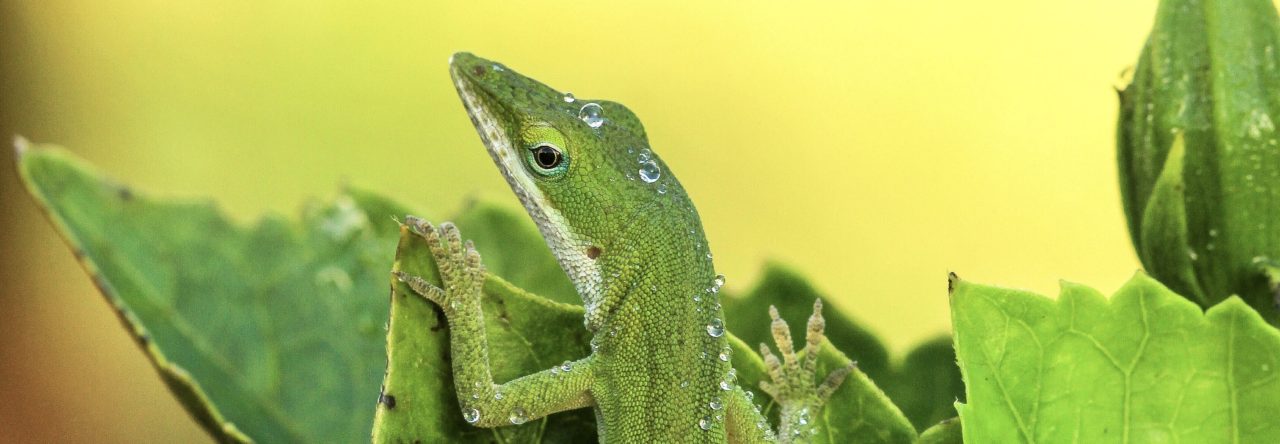
Geographic range of natural and introduced populations of Anolis sagrei. From Angetter et al. (2011).
The Cuban brown anole, Anolis sagrei, is indisputably the most successful of all Caribbean anoles. Not only is it found throughout almost all of Cuba at low elevations, but also everywhere in the Bahamas, on many islands in western Cuba, and even on the coast of Central America. Not surprisingly given its natural colonizing ability, the brown anole is the anole most widely introduced by humans as well, now established not only in Florida, but also on many islands in the Caribbean, as well as Taiwan, Hawaii and, most recently, Costa Rica.
What is surprising is how widely the brown anole has spread in North America. As the map above indicates, invasive populations have moved to areas much farther north than the species’ most northerly outpost in the Bahamas. One would think that Cuban anoles—or even Bahamian ones—would not be adapted to conditions in Georgia because environmental conditions are so different from those in Cuba.
To examine this idea, Angetter et al. conducted a species distribution modeling exercise to compare the environmental conditions that characterize the brown anole’s native range with that of its introduced range. Sure enough, they find that the introduced range is not well predicted by the environmental conditions of the natural range. However, Angetter et al. take the analysis one step further. Recognizing that environmental conditions were quite different 21,000 years ago, during the height of the Ice Age, the authors also characterize the brown anole’s environment (keeping its range constant) as it was at that time, and ask if the introduced range today can be predicted on that basis. The rationale here is that perhaps the brown anole still shows signs of adaptation to conditions in cooler times. However, even using this modeling, the introduced range is still poorly predicted.
This pattern can be explained in two ways. First, native populations of the brown anole may have the capability to live in a broader range of environments than they actually occupy. Perhaps the reason that it is not naturally found further north is simply the lack of available islands to the north to colonize. Nonetheless, the brown anole is not found at high elevations in Cuba, suggesting a lack of adaptation to cooler conditions. However, it may be the presence of ecologically similar species that occur at higher elevations that prevents the brown anole from occupying these habitats, rather than an inability to survive in such conditions.
The authors prefer a second explanation, that introduced species have adapted evolutionarily to the novel conditions they are encountering. Given the many examples of rapid evolutionary change under novel selective pressure that have now been documented, such an explanation is certainly plausible. Future research comparing the physiological ecology of native and introduced populations of brown anoles would prove very interesting to test this hypothesis.
One last anoline note. Angetter et al. use state-of-the-art statistical methods to compare the environmental niches of different species. Notably, these methods, now being widely utilized, were originally developed by anole biologists–including none other than AA’s own Rich Glor–and applied to anole questions.
- Evolution in Real Time on Lizard Island - March 23, 2025
- Spider Snags Adult Anolis osa - March 22, 2025
- An Homage to the Green Anoles of New Orleans - March 21, 2025


Benjamin Ross Desch
Is there much competition between A. carolinensis and A. sagrei? While geographic separation may maintain a low migration rate between the two land masses, what has prevented A. sagrei from establishing populations in the Southeast U.S. before now?
Jonathan Losos
Benjamin,
This is a very good question: if A. carolinensis can get to Florida from Cuba naturally, why not A. sagrei? I presume you were suggesting that competition from A. carolinensis prevented A. sagrei from getting established. Most people, however, think that if anything, the competitive superiority works the other way around, with A. sagrei displacing A. carolinensis, forcing it back up the tree to use the same microhabitat that it does in its native Cuba. This topic has been discussed several times in previous posts, such as here and here.
Benjamin Ross Desch
Interesting! Thanks!
julienneng
There is competition between carolinensis and sagrei, but carolinensis doesn’t appear to be a threat to sagrei. Rather, sagrei is the better competitor and has been driving carolinensis out of its normal range/microhabitat. The introduction of sagrei to the US was human-mediated and Kolbe et al. (2004) showed that with at least 8 introductions to Florida, introduced sagrei populations have greater genetic variation than native sagrei populations, making sagrei an invasive machine!
220mya
Is there any evidence of pre-Columbian human-aided dispersal of anoles?
Jonathan Losos
Not really, though it has occasionally been suggested. To me, the most interesting case is that of A. sagrei on Jamaica. It’s obviously a recent arrival, but more than a century ago, and who knows how much earlier, much less how they got there.
geneva
It’s been more than 10 years since Austin wrote about Lizards taking the express train to Polynesia and Jackman detailed how leather tanning moved clouded salamanders. Perhaps its time to take a similar genetic/historical approach on Jamaican sagrei. Are there strong ties between pre-Colombian Jamaican and Cuban human populations?
Allison DeVan
Very interesting. I’ll have to check up on the A. sagrei I saw in Savannah, GA (http://anoleannals.wordpress.com/2011/11/22/anolis-sagrei-in-savannah-ga/) next year to see if he survives the winter!
cybokat
thanks for the shout-out to my new host lab!